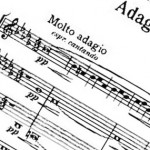The Music That Broke My Heart
- September 01, 2015
- By Dale McGowan
- In Intro
 1
1
During the weeks of shock and grief after the attacks of September 11, 2001, one piece of music was added to the programs of over 50 American symphony orchestras: Samuel Barber’s Adagio for Strings.
This piece was already special to me. When I first heard it at 18, I cried uncontrollably. It wasn’t just generally “sad” for me — it seemed to bring out the exact sequence of emotions I’d felt after the death of my dad five years earlier. I felt my grief unfolding in a painfully familiar way.
What the hell? There were no evocative lyrics, no title like “Death of a Dad” to prime my emotional pump — just pitches arranged over time, played by a string orchestra.
Five years later, after studying music theory in college, I sat down with the Adagio to figure out how Barber had communicated grief so effectively.
After a few minutes with the score, I saw what he’d done. It was brilliant, something anyone could understand if they just had a little [tippy title=”music theory”]The study of the grammar, syntax, and semantics of music.[/tippy]. Just a little music theory is all you need to unlock this emotional language and know how music works. Of course the great thing is that it works even if you don’t know how it does.
But oh, the knowing.
When the Adagio was added to the programs of all those orchestras after 9/11, NPR invited a “cultural commentator” to explain what it was about that particular piece that captured grief so well for so many people. Given his answer, he should have said, “Beats me.” Instead, he said roughly this:
When President Roosevelt died in 1945, the funeral planners went looking for appropriate music for his service. They knew they wanted something slow and beautiful. Barber’s Adagio, which was written just a few years earlier, was slow and beautiful, and it was selected for the funeral. Eighteen years later, the piece was played again for the funeral of JFK, in part because it had been in FDR’s funeral. From that point forward, Barber’s Adagio became associated with sadness in the national mind.
I was slack-jawed. He flipped the cause and effect. It’s like saying the 23rd Psalm is comforting because it’s been used to comfort people for so long. It’s like saying Tabasco sauce is considered hot because it’s in Cajun food.
Neither psalm nor sauce nor Adagio became what it is by association alone. In each case, most of what hits us is in the thing itself.
Tragedy, desperation, false hope, and exhausted resignation are all woven into the music of the Adagio, which then reaches me because my brain recognizes the emotional language in which it’s written. I knew how Barber had done it. But NPR never called, so I explained it to my dog.
He was impressed.
Eight years later, conductor and composer Rob Kapilow was talking about the Adagio on NPR for the Barber centennial. He said the kind of catharsis the piece goes through is similar to the catharsis at a funeral:
It starts from incredible sadness, builds to an incredible climax of intensity, and then finally reaches a kind of serene acceptance, which is completely appropriate for those occasions.
That’s good stuff. He’s talking funerals again, but he’s not saying funerals caused the music to sound sad. He’s saying the music parallels the emotional process in grief, which it does. Now he’ll talk about what makes the sadness, and what underpins that climax — the [tippy title=”harmony”]The relationship of pitches sounding at the same time.[/tippy].
It starts off with just a single note. And it’s so pure, it’s as if that note somehow was there forever.
That’s neat. Now talk about the harmony.
So Barber lets you sit there, with that one note on the violin, for an incredibly long time, and then the note gets drenched with the emotion of a rich chord in the strings. Finally it has to move, and it starts this lovely first phrase, which seems to take forever.
Yes, there is much foreverness. Now talk about the harmony. He knows what that “rich chord” is, of course — Kapilow’s an Eastman-trained composer. He just doesn’t think he can explain it to the layperson within the limits of a radio program. But this is NPR, dammit. That’s what they do.
He doesn’t have to say it’s a subdominant minor-minor seventh chord. But he can say this: Because of the grammar of music you’ve grown up hearing, the first two chords create an arrow of harmony that points your ears to a very specific place you don’t want to go. Then the next two chords suddenly lift you out of danger like a helicopter taking you off the roof.
Then you play those 30 seconds, and you can feel it happening.
In the next 30 seconds, after a moment of relief, you feel yourself sinking back to where we started — the same two chords, that harmonic arrow to despair. The escape didn’t work. Silence — then you try again.
But he doesn’t talk about harmony (notes played simultaneously). He talks about melody (notes played in sequence):
You have a sequence of three notes up, three notes up again, then you do it up a step. Then you do it again. And then … just, stop. The simplest pattern. A whole second wing of copying the pattern starts in the violas. Gradually, the slow repetitions acquire more expression and emotion. The piece gets higher and fuller.
It’s all true. The three-note, repeating-and-rising thing is very nice. But talking about the three-note melodic pattern as if it’s The Thing is like explaining the effectiveness of the “I Have a Dream” speech by describing Martin Luther King’s hand gestures. That’s part of what made the speech work, I suppose, but you can’t talk about why that speech became the iconic King speech without looking at the content, and the meaning that content conveyed.
In language, the primary (though not exclusive) vehicle of meaning is words and sentences. In [tippy title=”music”](i.e. Western tonal music).[/tippy], the primary vehicle of meaning is chords and chord progressions — the harmony.
He continues:
The simplicity of the logic is to make you feel the universality of the journey: from the simple note to the high emotional wailing to release and to final acceptance, but never in the place you thought it was going to lead you to.
Oo! That last bit was good. And what was that unexpected place? Not an unexpected three-note pattern. Not a sudden naked bagpipe solo. It takes you somewhere that’s harmonically unexpected. And if you (like me) were raised hearing the syntax and semantics of Western music, then Barber is speaking your language, and you feel it.
Yes, you need to know music theory to understand the harmonic language of music. But here’s the thing: you don’t need a lot of theory. You need just enough theory to unlock what’s going on. Maybe that’s still too much for a five-minute radio piece to get into, but a blog stretches to the horizon. We can even go beyond the theory to the fascinating intersection of physics, biology, culture, and personal experience that makes the emotional language of music comprehensible for one person or group but not another. So here we are, with you deciding whether to keep reading.
Keep reading.
If you’re willing to put in the effort to learn just enough theory, I’d love to share it. The basics will take about 12 posts, and I’ll scatter a lot of music in there as well. Then once we’ve covered the basics, we can talk about music in a whole new way, which is what the blog will do forever. For reference, the original teaching posts will always be in the right sidebar under the heading Just Enough Theory. I’ve also added a hover feature so you can get the definitions of a few key terms in any post. [tippy title=”Hover over any text with a blue dotted underline, like this…”]…and a quick definition or comment will pop up.[/tippy]
At some point, I’ll circle back and talk about the Adagio in great detail, but not for a while. First we’ll apply music theory to a lot of other music, especially music you suggest. To allow time for conversation in the comments, posts will be weekly for a while, then I’ll pick up the pace.
To play us out, here’s Leonard Slatkin and the St. Louis Symphony with the piece that made me want to know how music does that.
[arve url=”https://www.youtube.com/watch?v=wBK30bJagEA” /]
Click LIKE below to follow Dale McGowan on Facebook!
Photo of Vedran Smailović by Mikhail Evstafiev. Licensed under CC BY-SA 3.0 via Commons.
A blog about how music does that
- August 26, 2015
- By Dale McGowan
- In Intro
 0
0

On September 1st, I’ll start a new blog here about music — not what it does to your brain, or how it can make your children brilliant or magically shrink your tumors, but the seldom-discussed fact that another person can make you feel intense and specific emotions, even take you through a changing emotional landscape, just by arranging sounds in a certain way.
I know how music does that. It’s the most interesting thing I know. I used to have a job teaching it, and after several years away, I’m ready to do it again.
I’ll start by walking through just enough music theory, then apply it to TV and film scores, classical, rock, and video game music, the strange startup music in my Nissan LEAF, the saddest piece ever written, the universal teasing song, and the interval British people use to say good morning when they don’t really want to talk to you.
While you’re waiting, you can learn more about how the blog will work, subscribe by email in the sidebar, and Like the blog’s Facebook page.




